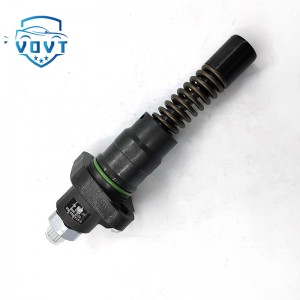New Original Pressure Regulator Suction Pressure Valve 0 928 400 788 SCV Valve for Auto Spare Parts 0928400788
Products Description
| Reference Codes | 0 928 400 788 |
| Application | / |
| MOQ | 12PCS |
| Certification | ISO9001 |
| Place of Origin | China |
| Packaging | Neutral packing |
| Quality Control | 100% tested before shipment |
| Lead time | 7~10 working days |
| Payment | T/T, L/C, Paypal, Western Union, MoneyGram or as your requirement |
What are the common faults of fuel metering valves?
Common fault types and manifestations
1. Valve stuck or blocked
Fault manifestation:
The engine is difficult to start or even cannot start.
Idle speed is unstable, the speed fluctuates greatly, and may be accompanied by shaking.
Insufficient power, slow response during acceleration, and obvious power reduction.
Uneven fuel injection leads to abnormal emissions (such as black smoke).
Cause analysis:
Poor fuel quality, containing impurities, moisture or colloid, which is deposited inside the valve, causing the valve core to be stuck.
The fuel system is not clean enough, and oil stains, metal debris, etc. block the valve hole or channel after long-term use.
The fuel filter fails, and unfiltered impurities enter the metering valve.
2. Solenoid valve coil failure
Fault manifestation:
The ECU detects an abnormality in the metering valve circuit, and the instrument panel may light up the fault light (such as OBD fault code).
The engine cannot receive the correct fuel metering signal, resulting in uncontrolled fuel injection, which may cause sudden flameout or abnormal acceleration.
When the coil burns out, the valve may be at a fixed opening (fully open or fully closed), resulting in abnormal fuel supply.
Cause analysis:
The coil works in a high temperature environment for a long time, and the insulation layer ages, shorts or breaks.
Circuit system failure (such as voltage fluctuation, poor wiring harness contact) causes coil overload or abnormal power supply.
The electromagnetic coil is subjected to mechanical vibration or impact, and the internal structure is damaged.
3. Aging or damage of seals
Failure manifestation:
Fuel leakage may cause oil stains at the interface of the metering valve, accompanied by abnormal increase in fuel consumption.
Failure of the seal causes air to enter the fuel system, causing engine air blockage, causing difficulty in starting or flameout during operation.
The common rail pressure is unstable, affecting the accuracy of fuel injection.
Cause analysis:
Seals (such as O-rings) are in contact with fuel for a long time, causing swelling, hardening or wear.
Improper operation during installation (such as excessive torque, interface misalignment) causes deformation or tearing of seals.
4. Wear or deformation of valve core
Failure manifestation:
Inaccurate valve opening control leads to failure of fuel flow regulation and fluctuation of engine power output.
The common rail pressure cannot be maintained, and the pressure may be too low (causing insufficient power) or too high (increasing the risk of knocking).
Abnormal noise at idle speed (such as "buzzing"), due to hydraulic shock caused by valve core wear.
Cause analysis:
Long-term high-load operation, frequent friction between the valve core and the valve seat, causing wear or scratches.
Hard particles in the fuel wash the surface of the valve core, causing geometric deformation.
When the engine is cold started, the fuel viscosity is high, the valve core movement resistance is large, and the wear is aggravated.
5. Line or plug failure
Fault manifestation:
The metering valve cannot receive the ECU signal, resulting in interruption or abnormal fuel supply.
Intermittent faults, such as occasional engine power reduction or flameout, and the fault code is sometimes present and sometimes absent.
Cause analysis:
The wiring harness plug is oxidized, loose or water-infiltrated, resulting in increased contact resistance or signal interruption.
The line is worn, squeezed or baked at high temperature, causing a short circuit or open circuit.
Troubleshooting and diagnostic methods
Read fault codes: Use a diagnostic instrument to read the fault codes stored in the ECU, such as "P0251" (fuel metering valve circuit fault), "P0252" (abnormal metering valve signal), etc., to preliminarily locate the fault range.
Fuel system inspection:
Detect fuel pressure: Use a pressure gauge to measure the common rail pressure. If the pressure is lower than the standard value at idle speed (such as 200-300Bar normally, it may be lower than 150Bar when faulty), it may be that the metering valve is not open enough.
Check fuel quality: Observe whether the fuel is turbid, contains water or impurities, and replace the fuel and clean the fuel tank if necessary.
Metering valve resistance test: Disconnect the wiring harness plug and use a multimeter to measure the resistance of the solenoid valve coil (the normal range is usually 2-5Ω, refer to the vehicle manual for details). If the resistance is infinite or 0, it means that the coil is damaged.
Power-on test: In a safe environment, apply rated voltage (such as 12V or 24V) to the metering valve, and observe whether the valve core moves (you can judge by auscultation or touch). If there is no sound or no movement, it means that the valve is stuck or the coil fails.
Appearance inspection: Disassemble the metering valve, check whether the seal is aged, whether there are scratches or deposits on the surface of the valve core, and clean or replace parts if necessary.
Preventive measures
Use high-quality fuel: Avoid adding fuel containing impurities and water, and replace the fuel filter regularly (it is recommended to replace it every 10,000-20,000 kilometers).
Regularly maintain the fuel system: Clean the fuel system every 50,000-100,000 kilometers to remove carbon deposits and colloid.
Pay attention to circuit protection: Avoid moisture and extrusion of the wiring harness, and regularly check whether the plug connection is firm.
Timely repair of minor faults: When an engine abnormality (such as power reduction, unstable idle speed) is found, check as soon as possible to avoid the expansion of the fault.

























